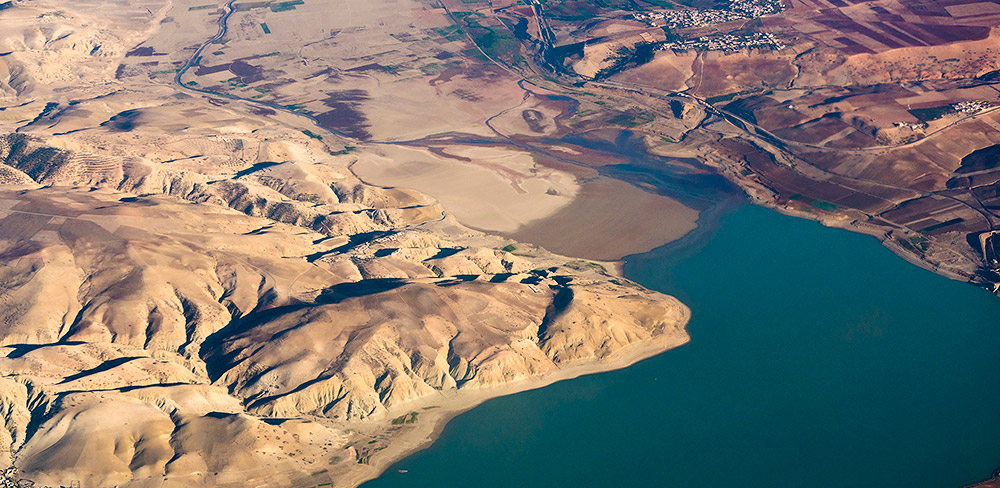New perspective on the history of the earth: The continents of the earth have evidently developed differently than expected, as isotope analyzes suggest. Accordingly, the new continental crust of the earth did not develop evenly in the course of the earth’s history, but in six bursts. In addition, the silicate content of the continent’s crust was already 3.7 billion years ago as high as it is today – until now some geologists have assumed an abrupt increase with the onset of plate tectonics.
In the beginning there was the ocean: Before the earthly land masses were formed, the crust of our planet consisted mainly of basaltic, oceanic crust. It was only later that the continental crust, which is richer in silicate, arose and the first land masses rose from the sea – according to the current theory. A possible trigger for this is the beginning of plate tectonics and the piling up of the first mountains. But when and how this happened is unclear due to conflicting data.
Time travel with sediment isotopes
“Our knowledge of the history of the continents is far from complete,” explains Marion Garçon from the University of Clermont-Auvergne and ETH Zurich. In addition to the beginning of plate tectonics, it is also controversial how evenly the continental crust grew and whether its composition has changed in the course of the earth’s history. According to some studies, there was an abrupt increase in the silicate content 2.5 to 3 billion years ago – possibly in connection with the beginning of plate tectonics.
To answer these questions, Garçon has now evaluated more than 2,600 isotope data from sedimentary rocks of various ages – from around 3.7 billion years ago to the present day. In particular, she compared the ratio of the isotopes samarium-147 to neodymium-144, from which conclusions can be drawn about the silicate content of the continent’s crust at the time the sediment was formed. In addition, she evaluated the ratio of neodymium-143 to neodymium-144, which reveals the proportion of young continent crust.
Silicate rich already 3.7 billion years ago
The first result: Contrary to popular belief, the silicate content of the continental crust has not changed significantly in the last 3.7 billion years. “The part of the continent’s crust that emerged was already rocky with a content of more than 60 percent silicon dioxide when the first remaining sediments were deposited,” writes Garçon. Even the oldest samples already correspond in their values to those of today’s continental crust.
According to the researcher, this suggests either that plate tectonics affects the crust composition less than assumed, or that the first forms of tectonics and subduction already existed 3.7 billion years ago. The latter would agree with the results of a recently published study of strontium isotopes in ancient barite minerals.
Six spurts of continent growth
But there is a second result – and this also contradicts some common assumptions. As the neodymium-143 to neodymium-144 data showed, the continental crust was not evenly reproduced in the course of the earth’s history. “The volume of the young continent crust was not constant over time,” reports Garçon. “Instead, a series of peaks and valleys appears.”
That means: In the course of the earth’s history, the continents grew in six distinct spurts, each following one another at intervals of 500 to 700 million years. In the present, however, the earth’s crust is in a phase of relative calm: “In the last 200 to 300 million years, the net volume of the continental crust has not changed significantly,” reports the researcher.
What were the triggers?
But what triggered these continental growth spurts? Garçon suspects that significant geological events were the cause. One possible explanation would be the formation of Magmatic Large Igneous Province (LIP) such as the Columbia and Karoo Flood Basalts or the Siberian and Deccan Trapps. They brought enormous amounts of magma to the surface. However, there are temporal coincidences with these events for only some of the growth spurts, as the researcher explains.
Another possibility would be the cyclical formation of supercontinents. Geologists have long suspected that the unification of the earth’s continents to form such gigantic land masses did not occur by chance in the course of the earth’s history, but repeated at intervals of around 500 million years. Variations in the speed of the tectonic plate movement are considered to be a possible cause. According to Garçon, they could also explain the bursts of accelerated crust growth.
However: There are also great uncertainties in the dating of the supercontinent development, which makes a comparison with the growth spurts of the continental crust difficult, as the geologist emphasizes. In this respect, their results offer new insights into the development of the terrestrial continent crust, but also raise new questions. (Science Advances, 2021; doi: 10.1126/sciadv.abj1807)
What: CNRS
–

